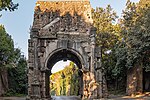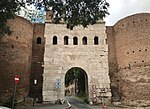Tomb of Priscilla
Ancient Roman buildings and structures in RomeAncient Roman tombs and cemeteries in Rome

The Tomb of Priscilla is a monumental tomb erected in the first century in Rome on the Appian Way (Via Appia Antica), situated opposite the Church of Domine Quo Vadis.
Excerpt from the Wikipedia article Tomb of Priscilla (License: CC BY-SA 3.0, Authors, Images).Tomb of Priscilla
Via Appia Antica, Rome Municipio Roma VIII
Geographical coordinates (GPS) Address Phone number Website External links Nearby Places Show on map
Geographical coordinates (GPS)
| Latitude | Longitude |
|---|---|
| N 41.8665 ° | E 12.5031 ° |
Address
Sepolcro di Priscilla
Via Appia Antica 64
00014 Rome, Municipio Roma VIII
Lazio, Italy
Open on Google Maps







